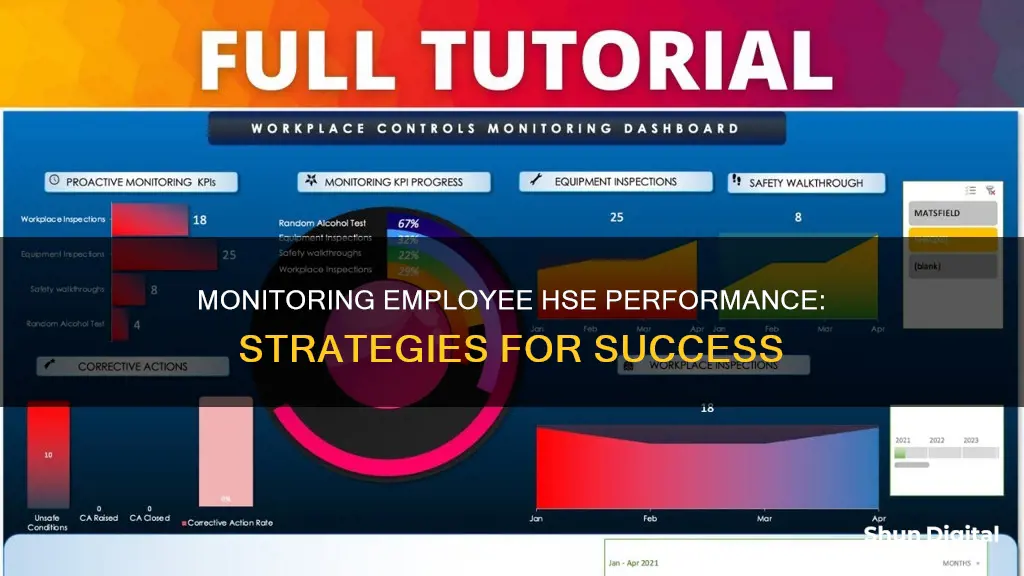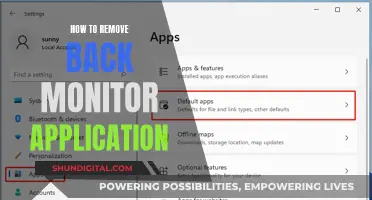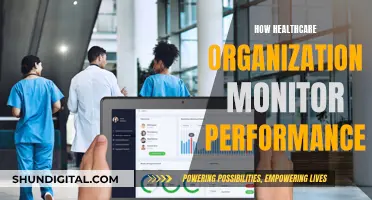
Monitoring employee health, safety and environmental (HSE) performance is an important aspect of maintaining a competitive business. It helps organisations to track and evaluate how employees handle their responsibilities and progress over time. Effective monitoring can also help organisations understand employee engagement and identify areas for improvement. There are several methods for monitoring employee HSE performance, including regular check-ins, performance management software, employee monitoring software, peer reviews, self-reported surveys, and more. By utilising these tools, organisations can gain valuable insights into employee performance and take necessary actions to improve productivity, efficiency, and overall employee well-being.
What You'll Learn

Regular check-ins and one-on-one meetings
Scheduling and Frequency
It is crucial to schedule regular one-on-one meetings with employees to discuss progress, address concerns, and provide guidance. These meetings should be held frequently and consistently to establish a transparent feedback loop. By doing so, managers can ensure they are on the same page as their employees and can provide support or address any issues before year-end reviews.
Agenda and Topics
During these check-ins, managers should create an agenda that covers various topics to understand their employees' performance and well-being better. This includes discussing the progress of projects, addressing any roadblocks or challenges, and providing a safe space for employees to voice their concerns.
Performance Evaluation
One-on-one meetings are also an opportunity to evaluate employee performance. Managers can ask employees to provide an account of their work since the last meeting, including the concrete actions taken and whether expectations were met. This helps hold employees accountable and allows managers to make informed judgments and provide guidance where needed.
Goal Setting and Tracking
These check-ins are also ideal for setting and reviewing goals. Managers can work with employees to set clear, measurable, and actionable goals and track their progress. This ensures employees understand what is expected of them and provides an opportunity to celebrate achievements or course-correct if needed.
Employee Wellbeing
In addition to performance evaluation, it is essential to prioritise employee wellbeing. Managers should use these meetings to check in on their employees' mental health and overall resilience. By creating a safe and supportive environment, employees are more likely to feel comfortable discussing any personal or professional challenges impacting their work.
Problem-Solving and Support
Regular check-ins allow managers to identify and address any problems early on. Managers can offer support, provide additional resources, or make necessary adjustments to an employee's workload or work environment to promote a healthy balance and optimise performance.
Two-Way Communication
While it is essential for managers to lead these meetings, it is also crucial to create a dialogue and encourage employees to share their thoughts and feedback. This creates a collaborative environment and ensures employees feel valued and heard.
By implementing these practices, managers can effectively utilise regular check-ins and one-on-one meetings to monitor employee performance, address concerns, and foster a positive and productive work environment.
Accessing Performance Monitor: A Step-by-Step Guide
You may want to see also

Use performance management software
Performance management software is an effective way to monitor employee HSE performance. These software solutions help organisations set goals, track progress and monitor employee performance in a centralised system. They also automate routine tasks like performance reviews and feedback documentation, freeing up time for managers and HR professionals.
There are several performance management software tools available, each with unique features and capabilities. Here are some popular options:
- BambooHR: This software helps HR departments create accurate reviews based on employee answers. It also allows managers to view employee progress reports and collect feedback.
- PerformYard: This software is designed to make HR processes easier through formal evaluations and reporting. It helps employees manage their daily, weekly, and monthly goals while providing employers with data to track these goals and offer feedback.
- Trakstar: This tool is highly trusted by HR and managers to evaluate employees. It keeps employees engaged and helps them stay on top of their goals. It also includes features for job description segments and team expectations.
- ChartHop: This platform allows users to personalise and tailor performance review questions to their organisation's needs. It helps reflect on employee performances and growth, and establish goals for the future.
- Eloomi: This tool assists employees with onboarding, evaluation, and training. It includes features such as video tutorials for specific skills, compliance surveys, daily checklists, and survey results sharing.
- AssessTeam: This software evaluates the 360-degree performance of an employee. It is easily installed and can be accessed through a mobile phone. It provides flexibility for the HR department to alter processes and provide feedback based on employee engagement with company values.
- Culture Amp: This software keeps the entire company aligned with its values and principles. It helps employees recognise their goals and expectations and empowers teams by creating a culture of feedback and progress.
- Lattice: Lattice encourages and motivates employees across departments. It helps management support their employees' growth within the company and provides features for regular updates, goals, and one-on-one sessions.
When selecting a performance management software, it is important to consider the specific needs and goals of your organisation. Some key features to look for include the ability to set clear benchmarks, automate tasks, share achievements and goals, enable self-evaluation, create periodic goals, and streamline the evaluation process for managers.
Easy Guide: Setting Up Telesense Remote Cardiac Monitoring
You may want to see also

Employee monitoring software
There are several employee monitoring software options available, such as Teramind, Veriato, ActivTrak, Controlio, Hubstaff, InterGuard, StaffCop, VeriClock, DeskTime, and Workpuls. These software solutions offer features like complex threat detection, activity tracking, time tracking, enterprise monitoring, task management, and employee privacy.
The use of employee monitoring software has become increasingly common with the rise of remote work. It helps managers gain insight into their team's hours and productivity. The software can track apps and websites used, take screenshots, monitor keystrokes, and provide detailed reports on employee productivity.
While employee monitoring software can be beneficial, it is important to consider the potential downsides. Employees may feel uncomfortable with the idea of being constantly watched, which could lead to low morale and high staff attrition. Additionally, productivity-monitoring efforts may backfire as employees may focus on meeting quotas rather than activities that benefit the company. Furthermore, managers may spend excessive time reviewing monitoring data.
Therefore, when implementing employee monitoring software, organisations should prioritise transparency, employee privacy, and clear communication of goals and benefits to mitigate potential negative impacts on company culture and employee trust.
Troubleshooting an ASUS Monitor Not Detecting HDMI on MacBook Pro
You may want to see also

Peer reviews and 360-degree feedback
In the context of monitoring employee performance, peer reviews and 360-degree feedback are valuable tools for gathering insights and evaluating employee performance from multiple perspectives. This approach can enhance self-awareness, promote accountability, and provide a comprehensive understanding of an employee's strengths and areas for improvement.
Peer Reviews
Peer reviews involve seeking feedback from an employee's peers, colleagues, or teammates, who have first-hand knowledge of their work. This can be done through formal or informal processes, such as surveys, focus groups, or individual interviews. Peer reviews can provide valuable insights into how an employee collaborates, communicates, and contributes to the team. It is important to ensure that peer reviewers provide constructive and objective feedback, focusing on observable behaviours and performance indicators.
360-Degree Feedback
On the other hand, 360-degree feedback takes a more holistic approach by collecting confidential and anonymous evaluations from a broader range of stakeholders, including managers, peers, direct reports, and sometimes even external stakeholders such as customers or clients. This method provides a well-rounded perspective on an employee's performance, including their strengths, weaknesses, and impact on different groups of people.
360-degree feedback can be highly effective in leadership development, improving customer service, enhancing teamwork and productivity, and building a competitive advantage for the organisation. However, it is important to carefully plan and implement this process, ensuring proper training for raters, maintaining anonymity, and focusing on relevant competencies and behaviours.
Best Practices for Peer Reviews and 360-Degree Feedback:
- Obtain feedback from a diverse range of sources to ensure a well-rounded perspective.
- Focus on specific competencies, behaviours, and performance indicators rather than personal characteristics.
- Ensure anonymity and confidentiality to encourage honest and unbiased feedback.
- Provide clear guidelines, instructions, and training to all parties involved in the process.
- Communicate the purpose and intended use of the feedback to all participants.
- Use the feedback constructively to create development plans and improve overall performance.
- Combine 360-degree feedback with other performance evaluation methods for a more comprehensive assessment.
Ankle Monitors: A Necessary Surveillance Tool for Law Enforcement
You may want to see also

Self-reported surveys
When constructing self-reported surveys, careful consideration should be given to the wording and structure to ensure responses are truthful and provide meaningful insights. For instance, surveys should be professionally scripted and carefully worded to elicit honest feedback while addressing specific areas of interest to the organisation. This approach ensures that employers gather the intended data while providing employees with a platform to communicate their perspectives.
One of the key benefits of self-reported surveys is their ability to improve employee engagement significantly. By actively seeking employee feedback, organisations demonstrate their commitment to transparency and employee involvement. This, in turn, can foster a culture of open communication and enhance employee satisfaction and motivation.
Furthermore, self-reported surveys can uncover valuable insights into the relationship between leadership styles and employee performance. For example, a GTE survey revealed that billing accuracy was closely tied to the leadership approach of unit managers. Units with managers who exercised a high degree of control made more errors than those with more autonomous workforces. As a result of this insight, GTE implemented changes in leadership styles, leading to significant improvements in billing accuracy over two years.
However, it is important to recognise the limitations of self-reported surveys. Employees may hesitate to provide completely honest feedback, especially if the surveys are not anonymous, out of concern for appearing negative or non-compliant with company politics. Additionally, without objective data, employees may struggle to provide concrete discussion points. To mitigate these challenges, organisations should emphasise the anonymity of the surveys and encourage employees to share their genuine experiences and perspectives.
Efficiently Eliminating That Pesky Point on Your Monitor
You may want to see also
Frequently asked questions
Regular check-ins and one-on-one meetings are a great way to monitor employee performance in a casual format. It helps to maintain a transparent feedback loop and fosters a positive working relationship between managers and employees.
Video calls, screen sharing, and remote-access programs can be used to monitor employees remotely. Self-monitoring tools like project plans, checklists, and activity logs can also be used to keep track of employees' actions.
Performance management software can be used to set goals, track progress, and monitor employee performance in a centralized system. Employee monitoring software can provide data to help guide conversations about performance and identify roadblocks hindering productivity.
Prioritising employee wellbeing and building stronger relationships with employees can boost their performance and productivity. Regular feedback helps employees stay on track and fulfill their goals.
Monitoring employee performance enables organisations to manage their operations and understand employee engagement. It helps HR and managers identify if employees are meeting, exceeding, or falling short of benchmarks, and take appropriate actions such as developing training programs or implementing rewards and recognition schemes.







